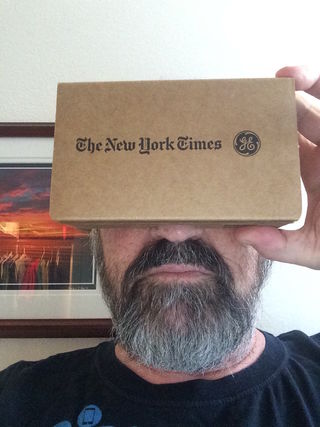Education
Google Cardboard as an Educational Tool
Can Virtual Reality Save Education?
Posted November 23, 2015

Many students will tell you that school is boring and their teachers are boring. Is it any wonder? These younger generations spend most of their day with their eyes glued to one screen or another. They watch videos and view websites in crisp high definition and listen to music with crystal clear sound, all from their smartphones or tablets. When they enter the classroom they turn off their phones, stow their tablets and sit back and are required to simply listen, watch and perhaps take notes. Rarely does instruction stray from the standard: teacher lectures, students listen. No wonder school is boring.
These are the same devices that they carry with them all day and sleep next to all night. They check their devices all the time. Our data show that more than two in three teens and young college students check their phones every 15 minutes or more often. Our data also show that when studying they lose their focus on schoolwork and switch to something more fun after a mere three to five minutes. Leo Yeykelis’ work at Stanford shows that they start to lose attention nearly 30 seconds before switching from studying to something fun like watching a video, playing a game or checking social media.
I was one of those New York Times subscribers who got a Sunday morning surprise a few weeks ago. When I first saw the rectangular package under the plastic sleeve holding my Sunday New York Times I thought, “oh boy, another cereal box.” Instead, I found a Google Cardboard viewer. I downloaded the app from the Times and went online to discover a few iOS apps using Cardboard (as it is known). I watched a car traverse a racetrack, a shark swimming around me and a roller coaster ride that felt so real that I had to pause to relieve my nausea. I was pretty darn impressed.
Maybe I am an old fogy, I thought, a 65-year old scientist, who has limited experience with 3D viewers other than my View Master from childhood and my vintage early 1900 stereoscope. Those most certainly showed pictures in 3D but Cardboard showed a 360-degree view plus constant motion in a reasonably crisp presentation. It seemed magical. To test this out I loaned my Cardboard to my friend’s 13-year-old son who also happens to be my computer guru and has been since he was about 9. I thought that he would be bored but he was actually impressed. I loaned it to a few other kids, teens and even young adults and all had the same reaction: Wow!
I have been talking for a long time about how we might enhance the educational environment in order to engage our younger generations of learners who have, as one study put it, the attention span of a goldfish. In my book, Rewired, I mused about using VR as an engaging vehicle to capture their attention. I postulated that the realism of a 3D environment might be just the modality to maximize presence—the feeling that one is immersed in a real world rather than a virtual one—and to use the immersive feeling that we get in 3D worlds to keep the student engaged. It certainly seemed to work on my small sample and I wonder now if this could be what we have been looking for to recapture the attention of our young learners.
In Rewired I talked about websites such as Second Life that might provide that immersive experience but rued the fact that it would take more processing power than currently in our laptops and desktops in school classrooms labs and a much stronger Wi-Fi signal than found on most campuses. Now we have a very cost-effective platform (Cardboard costs about $15 on Amazon at this writing) that, with a little ingenuity, can be used to engage our students. Imagine rather than listening to a lecture (complete with PowerPoint slides) on the Sistine Chapel, the student grabs Cardboard and watches a 360-degree video guided tour. The tour would include the ability to venture close to the ceiling and see Michelangelo’s brush strokes in the famous ceiling, as does Vassar College’s recreated Sistine Chapel on Second Life.
With Facebook’s acquisition of Oculus VR and the development of similar systems by Samsung (Gear VR), Microsoft (HoloLens) and Sony (Play Station VR), we now have the ability to use VR to enhance education. Nearly every student has a smartphone and can use it to watch 3D 360-degree videos. They can do it in the classroom or flip that classroom and use the glasses at home, on the bus, in a car, anywhere that they can get a good phone or Wi-Fi signal. This silly looking cardboard box may be just the cure for our boring education. Imagine learning algebra the same way you experience a roller coaster. It is certainly not the panacea for engaging our young learners, but it sounds like there might be potential for an educational breakthrough.
POSTSCRIPT:
On December 10th the New York Times released a well-crafted video called "Take Flight" to highlight Cardboard. You can see it in 2D here or in 3D on Cardboard.


